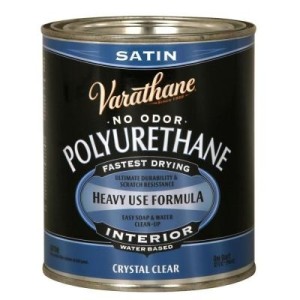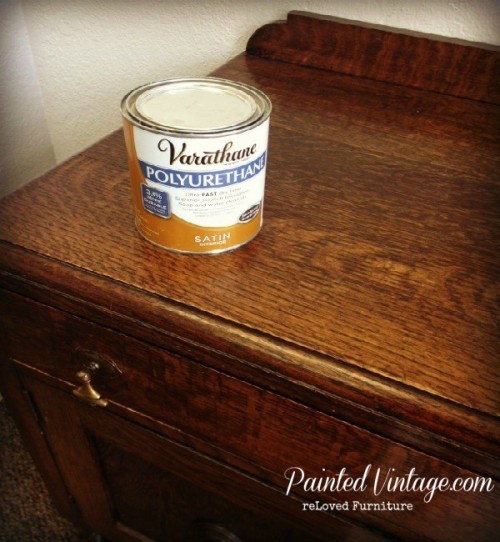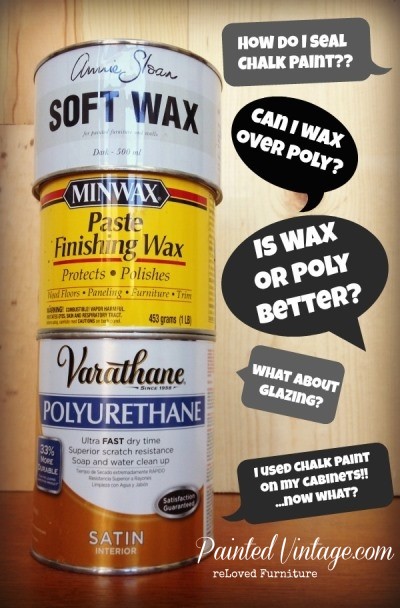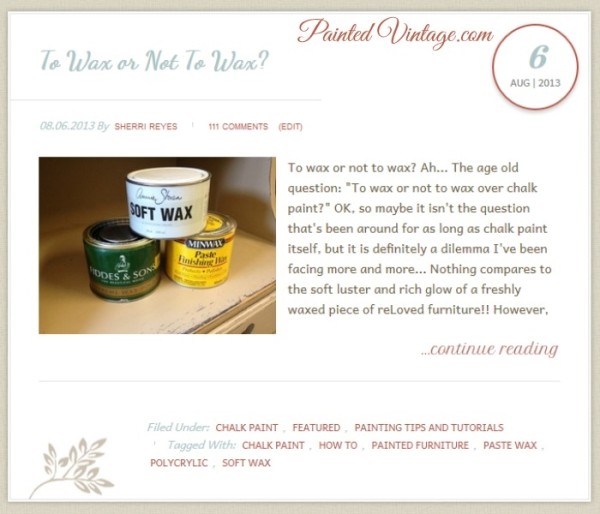Wax or Polycrylic over chalk paint?
All your questions about using wax vs. polycrylic over chalk paint answered!
The response has been overwhelming to my post on using wax or polycrylic over chalk paint (you can read the original post here: To Wax or Not to Wax?)
So, I decided to post an update with answers to your most frequently asked questions on applying a finish over chalk paint and wax alternatives.
Should I use a wax OR polycrylic over chalk paint? The answer really depends on how you will use the piece of furniture and how much time you are willing to invest in maintaining the finish. As I explained in my original post To Wax or Not to Wax? while waxing over chalk paint (or any variation of chalk style paint such as clay paint, mineral paint, and even DIY chalk paint) gives you a gorgeous velvety luster, it is NOT A PERMANENT finish and must be reapplied frequently to maintain the look and the protection of the wax. So if you absolutely must have the waxed finish, be prepared to also bust out a big can of elbow grease every few months!
That’s where water-based polyurethane finishes come in. Known as polycrylics, these finishes are an excellent alternative to use over chalk paint, for several reasons. Mostly they offer more of a permanent, durable finish that does not need to be reapplied. They are not heat sensitive like waxes are and they do not need to be completely removed should you chose to repaint. Oh, and they do not require any special courses in correct application techniques!
So for me personally, polycrylic wins the wax vs. poly challenge, hands down as my go-to finish of choice over chalk painted furniture.
What kind of wax would you use? Honestly, I rarely wax over chalk painted furniture anymore. But occasions do arise when I will use waxes. I love Minwax Paste Finishing Wax. It’s easy to work with and buffs out to a gorgeous finish! Another big plus is that it’s easy to find!! If I am going to be using a dark wax, I like the Annie Sloan Soft Wax.
What type of clear sealer do you use over chalk paint? There are several brands of water based polycrylics available. Admittedly, I have not tried them all, but I have tried several. I really like the Minwax Polycrylic, and I also love ease of the Minwax Wipe-On Poly for small projects. But, my all-time favorite is Varathane Crystal Clear Water-Based Polyurethane.
 Varathane Crystal Clear Poly goes on a little milky, but dries clear and stays clear! I have NEVER had any issues with Varathane Crystal Clear yellowing, as some polycrylics can over white painted furniture. This is my go-to product when applying a polyurethane over WHITE chalk paint. It is getting harder to find this product. But depending on which state you live in, you can still order online from HomeDepot.com
Varathane Crystal Clear Poly goes on a little milky, but dries clear and stays clear! I have NEVER had any issues with Varathane Crystal Clear yellowing, as some polycrylics can over white painted furniture. This is my go-to product when applying a polyurethane over WHITE chalk paint. It is getting harder to find this product. But depending on which state you live in, you can still order online from HomeDepot.com
In my area, the Crystal Clear formula has been replaced with a white labeled can that just reads: Varethane Polyurethane. I have been using this product for several months, and so far **knocking this wood buffet** I seem to have the same results as the Crystal Clear formula. UPDATE 9/15/14: I contacted Rustoleum and have been told the white label can is NOT the beloved Crystal Clear Formula. So , while I have not experienced any yellowing, I just want to clarify, THIS IS NOT IS CRYSTAL CLEAR FORMULA.

I should point out that POLYCRYLIC generally refers to a water-based finish, and POLYURETHANE refers to an oil-based finish. Varathane calls both their water-based and oil-based formulas by the generic “Polyurethane” name. In this post, I am specifically referring to the water-based formula only. Oil-based polyurethanes WILL AMBER over time.
How do you apply the poly over chalk paint? Using a good quality synthetic brush (Purdy’s are my preference) apply the poly in the direction of the natural wood grain. Using long, even strokes, work in one direction only, and try not to “over work” it by going back and forth into the wet area. Allow it to dry a couple hours between coats. While it does not require sanding between coats, I will sometimes sand lightly with a brown paper bag (yes, the grocery / lunch sack kind) if I need to knock down any bumps or little ridges. This can also be done after to buff it out to a gorgeous shine.
I have already waxed over my chalk paint, can I just apply poly over the wax? No. If you have used wax, it must be completely removed prior to applying anything. You cannot apply polycrylic over a waxed surface. You see, as the wax dries it becomes a natural water repellant. WAX REPELS WATER. That’s what wax does. Therefore, the poly has nothing to adhere to, because the wax is busy doing its job of repelling… An easy rule of thumb to remember IF your are going to use wax: “WAX IS LAST”
“Wax is Last”
Now, I have read that Annie Sloan wax can be top-coated with a polycrylic. Besides ASCP, I have also heard other chalk style paint manufactures claiming that you can apply poly over wax. I personally will never recommend that, and neither do the polycrylic manufactures. The back of my can reads “surface must be free from wax before applying” in two different areas of the label.
What about painting over wax? Same concept as above applies. If you would like to repaint furniture that has already been chalk painted and waxed, you must remove the wax first. Paint will not adhere directly to the wax. Wax can be removed by wiping the surface down with mineral spirits. Once the wax has been removed, you can proceed with your project. (Now I personally, would still prime with Zinsser Cover Stain, but I’m old school that way.)
Again, I have heard Annie Sloan Chalk Paint and a few other chalk-style manufactures say you can apply chalk paint, clay paint, or mineral paint directly over wax. I personally, would never suggest this. My preferred method for painting over wax, is to remove the wax FIRST. (…annnnd I’d probably prime)
Can I apply wax over polycrylic? Yes, you can. If you want the durability of the poly, but the look of a wax, you can use them together AS LONG AS THE WAX IS THE FINAL COAT. Because of the nature of wax and the way it cures, I would suggest using a matte poly if you want a wax top coat. Allow it to dry completely before waxing.
Can I apply Dark Wax over poly? Yes. Remember the rule “Wax is Last” So if dark wax is going to be your last step, you can absolutely apply it over poly. If you have just painted furniture with chalk paint and you want to really bring out the details and give your piece some character, dark wax is a wonderful product. Apply the poly first, so the dark wax does not stain the porous chalk paint.
Can I glaze over the poly? Yes, you can. If you want to add a dark glaze over chalk paint, apply a light coat of poly so the glaze does not stain the porous chalk paint. You can then glaze on top, once the poly is dried. You’ll want to apply another coat or two of the poly after you’ve waited patiently for the glaze to completely dry- don’t rush the waiting part here… it’s important. Otherwise you’ll make a mess- just trust me…
Can I use Chalk Paint over the polycrylic? Yes, you can. That is one of the benefits of using a polycrylic vs wax. If you change your mind on the color, or simply want to repaint your furniture piece later on down the road, you can do that! The poly does not need to be removed.
What kind of sealer do you recommend for Chalk Painted kitchen cabinets? A polycrylic would be my preference. I would not use a wax for a few reasons. If you’re like me, your cabinets will need to be wiped down almost daily. Splashes, spills and tons of chocolatey little fingerprints may need to be scrubbed. Lots of heat from all the cooking and baking that may (or may not) be going on… Wax will wear down very quickly under those conditions and will need to be re-applied more frequently. Let’s face it, waxing kitchen cabinets is not high on my monthly to-do list of chores. If I am going to spend the time to redo kitchen cabinets, I only want to do it once, and forget it! I really don’t need frequent reminders of what hard work that can be!
What kind of sealer can I use on my kitchen table top? For the same reasons listed above, I would use a polycrylic. At least 4-6 coats would provide a gorgeous, durable finish that would hold up well under the use and abuse a kitchen / dining table may receive. If I really wanted a virtually indestructible finish, I’d go with the Varathane Floor Finish.
Disclaimer: Although I think I would be a heck of a great spokesperson… (are you listening @rustoleum??) I am not sponsored or compensated in any way by Varathane. I just love the brand and have used it for dozens of years, even back when it was called Diamond by Flecto.
I hope you will find my answers to these frequently asked questions helpful in your research about using wax or polycrylic over chalk paint. These are actual questions I have been asked by my readers, and the answers given are what I would do in a given situation, based on my personal experiences. If you’d like to read my original post, you can find it here:








Thanks for your this very helpful post!
I was just wondering if after painting furniture with chalk paint, then applying varathane poly crystal clear formula as top coat. Does the paint look cracked?
Very helpful! So glad I came across this post. I’m building end tables and a coffee table today. So I’ve been sitting on both a can of wax and polycrylic, trying to decide which is best after they’re chalk painted. Now I know to poly it with about 4 coats then wax it last for double durability. The finish I want, but the proper steps to do it. Thank you!
How do you remove the issue where bit of the paint look dry or a different shade after poly has been applied
I have painted my coffee table using chalk paint. I want it to have a very durable finish but I also want to use dark wax to bring out some of the details. Should I use a few coats of poly, then clear wax, then dark wax? Do I even need the clear wax step?
This was a great article! Thank you for taking the time to explain the pros & cons of both. Very helpful
I have heard that a polycrylic sealer over dark chalk-based painted surfaces will produce a haze. Have you ever heard of this? I’ve been doing some reading and one site mentioned not waiting long enough for the paint to dry thoroughly will cause this as the moisture still in there gets trapped. It said humidity plays a big part in the drying process so wait at least 24 hours. What do you think about this information?
I used the diy calcium carbonate chalk paint on a dresser in a medium gray color. About a week later I put a coat of polycrylic over it and it turned the piece yellow immediately I assumed this was the original stain bleeding through. Have you ever had this issue? What did I do wrong? The paint alone looked great until I applied poly. Now it looks terrible and I’m feeling very discouraged. thank you in advance for your advice and comments!
thank you in advance for your advice and comments!
Whay brand of poly did you use? Some are known for more yellowing than others.
I had that mistake before as well! I had to sand the whole thing back down and start over. Very frustrating! My problem was that I accidentally used polyurethane instead of polycrylic. Perhaps you picked up the wrong can as well? Good luck!
Can you used the oil-based poly over wax?
I would never recommend poly over wax… some do, I am not of that schooling however.
Thank you for the much needed information. I am going to chalk my bathroom cabinets and finish with the poly. So wxcited!
What about the brush marks from chalk paint, will the poly take care of these?
you have helped me so much. I think if I had used a wax on my granddaughters table it would be a few months and it would look awful. So now that I have done the chalk paint I will do the polycrylic. You have so much information that has helped me not make some big mistakes. Thank you
Menard’s if they are in your area carry the Varathane Crystal Clear in all finishes and both quart and gallon sizes. I always use this when I chalk paint too. Bonus, I used to have to stock up when traveling where a Menard’s is located, but one just opened 20 minutes from me!
I have always used polycrystalline but recently decided to try the wax. It’s not for me so know I’m looking for the easiest way too rest rip it off. Any tips?
Help! I chalk painted my desk & it was beautiful UNTIL I applied my 1st coat of poly (the one you recommend). I should have read this article better, but I realize now I didn’t only go in one direction & I overworked it. Is there any way to get rid of the yucky streaks it left me with, or do I need to chalk paint it again & start over with the poly?
Should be easy enough to fix. I’ve never used poly over chalk paint but have worked with it a lot on bare wood. I would recommend sanding with a fine grit. Clean up dust well and then do another layer of poly. Repeat as necessary. This will even the finish.
I polyacylic chalk paint and I put dark wax on after. The next day I buffed it and a lot of the wax came off. Is that normal, do I have to distress after I polyacylic?